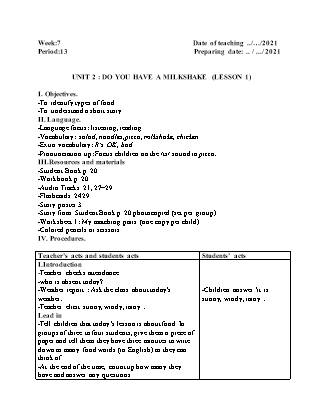Giáo án Tiếng Anh Lớp 3 - Unit 3: Do you have a milkshake - Lesson 1 - Năm học 2021-2022

I. Objectives.
-To identify types of food
-To understand a short story
II. Language.
-Language focus: listening, reading
-Vocabulary: salad, noodles, pizza, milkshake, chicken
-Extra vocabulary: It’s OK, bad
-Pronunciation tip: Focus children on the /ts/ sound in pizza.
III.Resources and materials
-Student Book p. 20
-Workbook p. 20
-Audio Tracks 21, 27–29
-Flashcards 2429
-Story poster 3
-Story from Student Book p. 20 photocopied (set per group)
-Worksheet 1: My matching pairs (one copy per child)
-Colored pencils or scissors
IV. Procedures.
Bạn đang xem tài liệu "Giáo án Tiếng Anh Lớp 3 - Unit 3: Do you have a milkshake - Lesson 1 - Năm học 2021-2022", để tải tài liệu gốc về máy bạn click vào nút DOWNLOAD ở trên
Week:7 Date of teaching ../ /2021 Period:13 Preparing date: .. / .../ 2021 UNIT 2 : DO YOU HAVE A MILKSHAKE (LESSON 1) I. Objectives. -To identify types of food -To understand a short story II. Language. -Language focus: listening, reading -Vocabulary: salad, noodles, pizza, milkshake, chicken -Extra vocabulary: It’s OK, bad -Pronunciation tip: Focus children on the /ts/ sound in pizza. III.Resources and materials -Student Book p. 20 -Workbook p. 20 -Audio Tracks 21, 27–29 -Flashcards 2429 -Story poster 3 -Story from Student Book p. 20 photocopied (set per group) -Worksheet 1: My matching pairs (one copy per child) -Colored pencils or scissors IV. Procedures. Teacher’s acts and students acts Students’ acts I.Introduction -Teacher checks attendance -who is absent today? -Weather report : Ask the class about today's weather. -Teacher elicit sunny, windy, rainy . Lead in -Tell children that today’s lesson is about food. In groups of three to four students, give them a piece of paper and tell them they have three minutes to write down as many food words (in English) as they can think of. -At the end of the time, count up how many they have and answer any questions. -Ask them to compare their paper with the group next to them and cross out any words that are the same. -They can then teach each other any extra words left on each piece of paper. -Monitor and help with spelling and pronunciation. Use Flashcards to elicit the food vocabulary for this lesson. Hold them up one at a time for children to name the different types of food. Model any words that children do not know. -Hold the flashcards up in a different order and repeat. II.Presentation Listen, point, and repeat. (Exercise 1) -Ask children to look at the pictures in their Student Books of the different kinds of food. -Play the first part of the recording (Track 27) for children to listen and point to the pictures. Hold up the appropriate flashcard as each word is said. -Play the second part of the recording, pausing after each word for children to repeat. -Play the recording all the way through for children to listen and point and then repeat the words. -Hold up the flashcards in a random order and ask the class to say the words Listen and chant. (Exercise 2) -Play the recording (Track 28) for children to listen to the chant. -Play the chant a second time for children to repeat the words in the pauses. Repeat (more than once if necessary). -Encourage the children to say the chant as a class, without the recording. Mime it! -Divide the class into five groups, one for each type of food. -Tell the children they have that kind of food in front of them, and they are about to eat (or dink) it. -Play the recording for the children to do the chant again. When their food is mentioned, they mime eating or drinking it. IV.Development Listen and read. (Exercise 3) -Use Story poster 3 to present the story. Talk about each frame one at a time with the class. Encourage predictions about the story from different members of the class. -Ask children to look at the story in their Student Books. Play the recording (Track 29) for them to listen and point to the different speech bubbles as they hear the words. -Ask questions to check comprehension, e.g., Where are Mom, Rosy, and Billy? Does Rosy give Billy a sandwich? Does Billy eat the sandwich? -Ask children to look at the story again. They find and point to the words from Exercise 1. V.Consolidation What’s missing? -Tell the class that you are going to have a picnic, but there are some very angry birds in the trees. Put the food flashcards on the board for the children to say what you have at your picnic. -Ask the children to close their eyes (and put their heads down on the desk!). Remove one flashcard and rearrange the others and ask the class to tell you what the birds have taken. Worksheet 1: My matching pairs -Ask children to look at the example cards for pizza on Worksheet 1. -They should complete the rest of the cards by writing the word and drawing a picture of the target vocabulary milkshake, noodles, salad, and chicken. -When the cards are completed, ask children to cut them up and exchange cards with their partner. Their partner should try to match the picture and the words of the new set of cards. -Tell the children they can practice this matching game at home with their family, but they should bring the cards back to use again in the next lesson. Exercises: Workbook p. 20 -Children answer ‘it is sunny, windy, rainy . Listen and point. salad, noodles, pizza, milkshake, chicken pizza, salad, chicken, noodles, milkshake Listen and repeat. salad, noodles, pizza, milkshake, chicken Where are Mom, Rosy, and Billy? Does Rosy give Billy a sandwich? Does Billy eat the sandwich? salad, noodles, pizza, milkshake, chicken pizza, salad, chicken, noodles, milkshake
Tài liệu đính kèm:
 giao_an_tieng_anh_lop_3_unit_2_do_you_have_a_milkshake_lesso.docx
giao_an_tieng_anh_lop_3_unit_2_do_you_have_a_milkshake_lesso.docx



